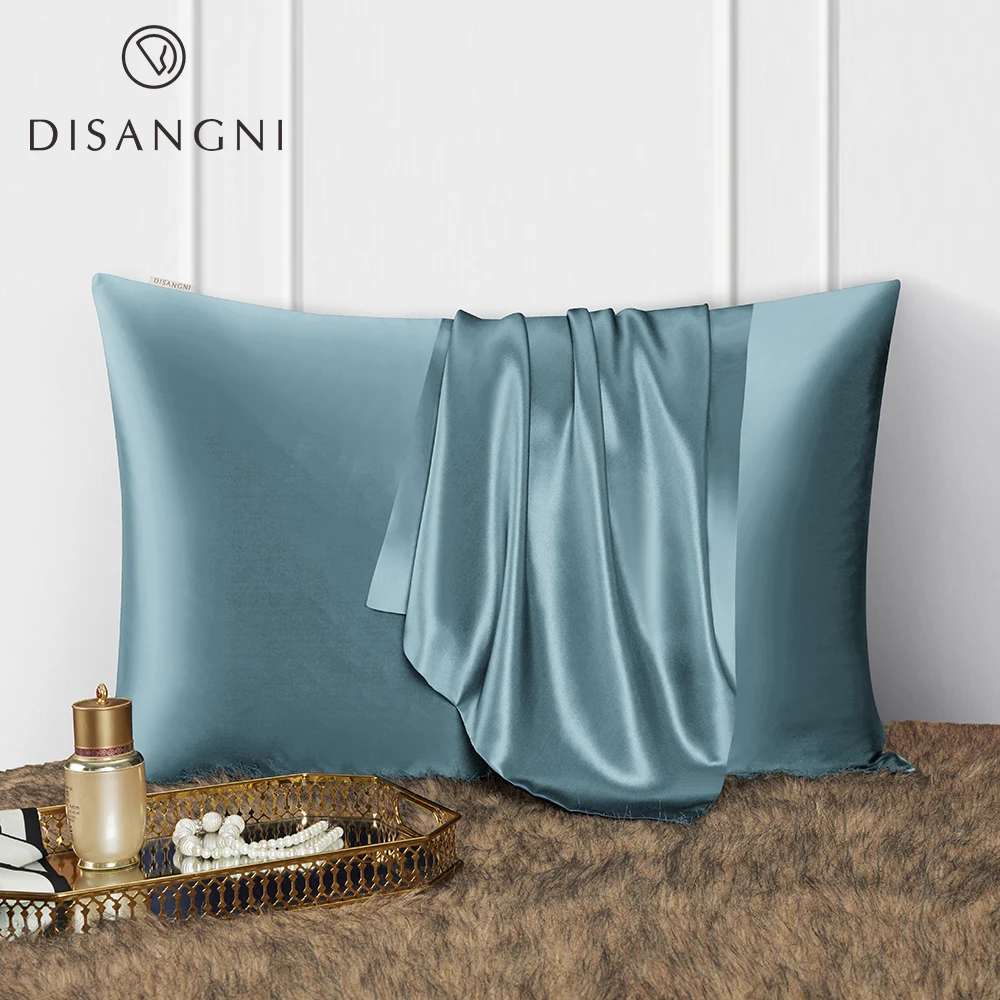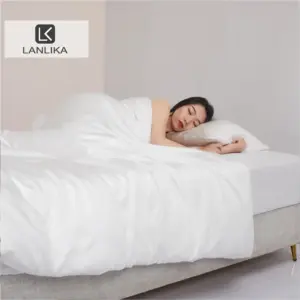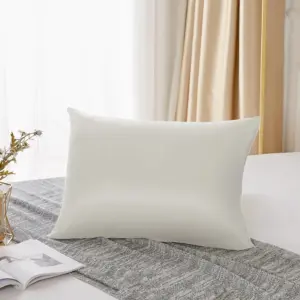Introduction: Why Your Bedding Choice Matters for Sensitive Skin
Living with sensitive skin means being constantly vigilant about potential irritants—from skincare products to clothing and especially bedding. Sensitive skin is characterized by frequent redness, irritation, dryness, and heightened reactions to environmental factors that might not affect others. What many people don’t realize is that conventional bedding can significantly aggravate these conditions through constant friction, moisture absorption, and allergen retention.
Consider this: the average person spends approximately one-third of their life in bed—that’s about 26 years or nearly 230,000 hours of direct contact between your face and your bedding. During this time, your skin is continuously interacting with fabric fibers, absorbing or losing moisture, and being exposed to whatever allergens your bedding harbors.
This is where mulberry silk enters the picture as a scientifically-supported solution for sensitive skin concerns. The amazing benefits of mulberry silk sheets extend far beyond luxury, offering unique properties that can transform the sleep experience for those with reactive skin. Let’s explore why your bedding choice could be the missing piece in your sensitive skin care routine.
Understanding Sensitive Skin and Its Unique Challenges
Sensitive skin is more than just occasional irritation—it’s a persistent condition affecting approximately 15-20% of the population. From a medical perspective, sensitive skin involves a compromised skin barrier function, making it more reactive to stimuli that wouldn’t normally cause issues for others.
Common symptoms of sensitive skin include:
– Frequent redness and flushing
– Burning or stinging sensations
– Dryness, flaking, or peeling
– Breakouts and blemishes
– Reactions to products that others tolerate well
– Visible blood vessels near the skin surface
– Rough or uneven texture
During sleep, these symptoms can worsen significantly. Traditional bedding materials often contain coarse fibers that create micro-abrasions on delicate skin. Cotton, while natural, has rough fiber ends that can snag and irritate. Synthetic materials trap heat and moisture, creating the perfect environment for bacteria growth and preventing your skin from breathing properly.
The problem compounds when you consider that nighttime is when your skin should be recovering and repairing itself. Instead, many people with sensitive skin wake up with increased irritation, new breakouts, or heightened redness because their bedding is working against them, not for them. Is silk good for sensitive skin? The evidence strongly suggests it is, offering a solution to these nighttime challenges.
The Science Behind Mulberry Silk’s Skin-Friendly Properties
To understand why mulberry silk offers exceptional benefits for sensitive skin, we need to look at its unique molecular structure. Unlike plant-based fibers, mulberry silk consists of fibroin protein—remarkably similar in composition to human skin proteins—making it inherently biocompatible with our skin.
Microscopic Smoothness
Under a microscope, silk fibers measure just 12-15 microns in diameter compared to cotton’s 20-30 microns. This significant difference creates an ultra-smooth surface that minimizes friction against sensitive skin. The natural protein structure of silk also lacks the microscopic barbs and rough edges found in plant-based fibers.
Natural Protein Composition
Silk contains 18 amino acids that have nurturing effects on human skin. These proteins create a fabric that interacts harmoniously with our skin’s natural chemistry rather than fighting against it. This compatibility is why many dermatologists recommend silk for patients with reactive skin conditions.
Moisture Management
The hygroscopic properties of silk allow it to regulate moisture without absorption. Unlike cotton, which draws moisture away from your skin, silk maintains an optimal balance—neither too dry nor too humid. This prevents the dehydration that often triggers sensitivity and flare-ups.
Temperature Equilibrium
Silk fibroin contains natural temperature-regulating properties that adjust to your body’s needs. This prevents the overheating that can trigger inflammatory responses in sensitive skin while still providing insulation when needed.
What makes mulberry silk special is this rare combination of properties that work together to create an ideal sleep environment for sensitive skin. The scientific evidence supports what many users discover through experience—that silk offers unparalleled benefits that synthetic alternatives simply cannot replicate.
Hypoallergenic Properties: Why Silk Naturally Resists Irritants
When we describe mulberry silk as hypoallergenic, we’re referring to its remarkable natural resistance to common irritants that plague sensitive skin sufferers. This resistance stems from the unique protein structure of silk rather than chemical treatments found in many “hypoallergenic” synthetic products.
Silk’s hypoallergenic advantages include resistance to:
– Dust mites (studies show up to 70% fewer dust mites in silk bedding compared to cotton)
– Mold spores and fungal growth
– Common environmental allergens
– Bacterial colonization
The secret lies in sericin, a protein naturally present in silk that creates an environment inhospitable to dust mites and other allergens. Additionally, silk requires minimal chemical processing compared to cotton and synthetic fabrics, which often contain residual pesticides, formaldehyde, and other chemical finishes.
For allergy sufferers, this means fewer nighttime symptoms like congestion, sneezing, and skin reactions. The natural silk properties benefit sensitive skin by creating a cleaner sleep surface that doesn’t harbor the irritants that trigger reactions. This makes mulberry silk an excellent choice for those with environmental sensitivities as well as contact allergies.
Unparalleled Smoothness: How Silk Minimizes Friction Against Skin
The exceptional smoothness of mulberry silk provides perhaps its most immediate benefit for sensitive skin. Fabric friction is measured using a coefficient—the lower the number, the smoother the fabric. Mulberry silk boasts an impressive friction coefficient of just 0.1-0.2, compared to cotton’s much higher 0.5-0.6.
This dramatic difference in smoothness translates to several significant benefits:
- Prevention of micro-abrasions that can occur when skin drags against rougher fabrics
- Reduction of sleep creases that can become more permanent over time
- Minimal tugging on delicate skin, particularly important for aging or compromised skin
- Less irritation for conditions like eczema where skin barrier function is already impaired
The charmeuse weave commonly used in high-quality mulberry silk sheets enhances this natural smoothness by creating an exceptionally flat, lustrous surface. The difference between sleeping on silk versus conventional fabrics is often described as “gliding” rather than “dragging” against the skin.
For conditions like eczema or psoriasis, where the skin barrier is already compromised, this reduced friction can mean the difference between skin that heals overnight and skin that becomes further irritated. The gentle contact against inflamed areas allows healing to progress without the constant micro-trauma caused by rougher fabrics.
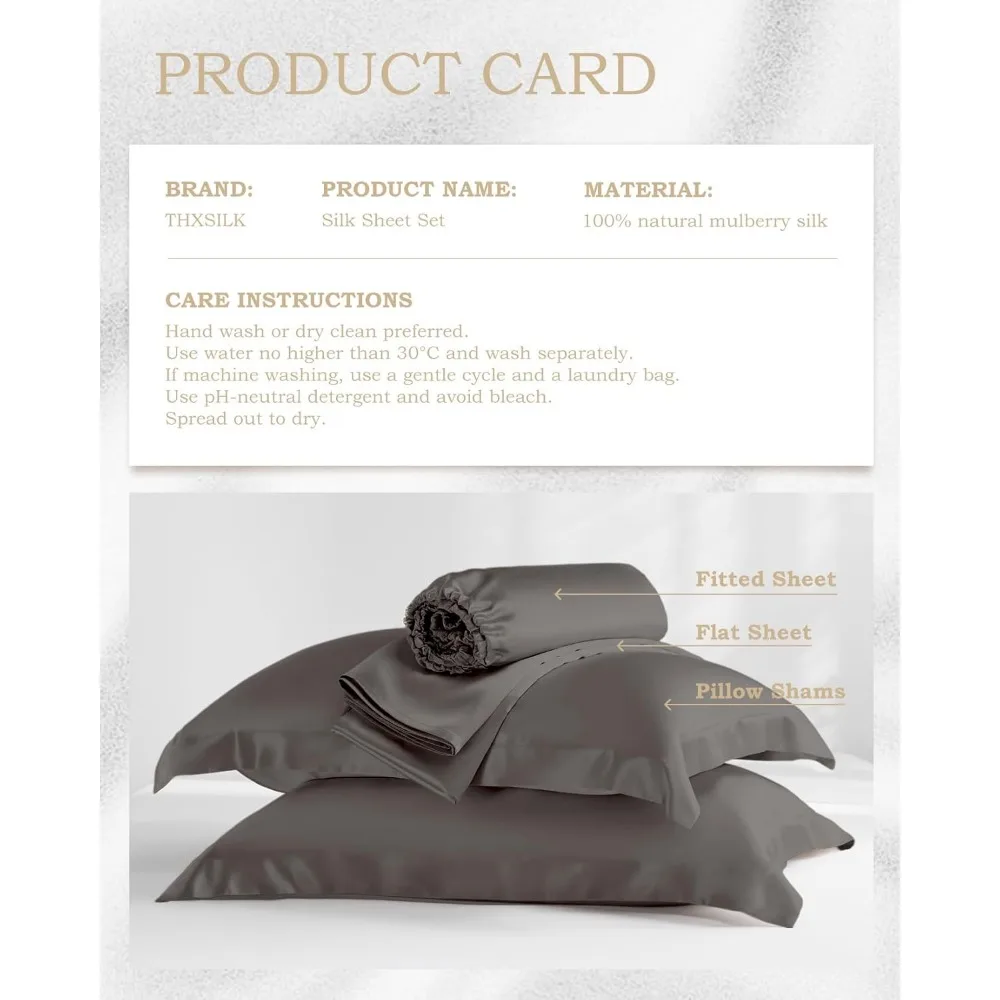
Moisture Balance: Silk’s Role in Maintaining Skin Hydration
Proper skin hydration is crucial for those with sensitive skin, and this is where mulberry silk truly excels compared to other bedding materials. During sleep, your skin undergoes transepidermal water loss—a natural process where moisture evaporates from your skin into the surrounding environment.
Silk’s relationship with moisture is uniquely beneficial:
– It absorbs only about 11% of its weight in moisture compared to cotton’s 27%
– It wicks excess moisture away without over-drying the skin
– It maintains the delicate moisture balance required for skin barrier function
– It preserves the natural oils your skin needs for protection
This balanced moisture management is particularly valuable if you use nighttime skincare products. Unlike cotton, which often absorbs expensive serums and creams, 100% silk sheets allow these products to remain on your skin where they belong. The natural proteins in silk work in harmony with skincare ingredients rather than competing with them.
For those with dry, flaky skin conditions, this moisture preservation can significantly reduce symptoms like tightness and itching. By maintaining optimal hydration levels throughout the night, silk helps strengthen your skin’s natural barrier function—the foundation of resilient, less reactive skin.
Temperature Regulation: Preventing Heat-Induced Skin Flare-ups
Temperature fluctuations during sleep can be a major trigger for sensitive skin flare-ups. Overheating often leads to increased blood flow to the skin’s surface, triggering inflammation, redness, and intensified sensitivity. Many fabrics trap heat against the skin, creating a problematic cycle of overheating and sweating.
Mulberry silk’s thermoregulating properties work differently:
– The natural protein structure creates microscopic air pockets that provide insulation in cool conditions
– These same air spaces allow excess heat to dissipate in warm conditions
– Studies show silk maintains a 1-2°F (0.5-1°C) more stable temperature than synthetic fabrics
– Reduced sweating means fewer irritants on the skin surface
This temperature stability is particularly important for conditions like rosacea, where heat triggers can cause painful flares. Cooling silk sheets provide an even more enhanced cooling effect, making them ideal for hot sleepers or those whose skin conditions worsen with heat.
By preventing the temperature spikes that trigger inflammatory responses, silk helps maintain a calmer, less reactive skin environment throughout the night. This stability extends beyond comfort—it’s a therapeutic benefit for many chronic skin conditions.
Mulberry Silk Benefits for Specific Skin Conditions
For Eczema/Atopic Dermatitis
- Significantly reduces friction against damaged or cracked skin areas
- Maintains essential moisture barrier that helps prevent the itch-scratch cycle
- Natural proteins create an environment less conducive to bacterial growth, reducing infection risk
- Smooth surface prevents snagging on flaky skin patches
- Breathability prevents the heat buildup that can trigger intense itching
For Acne-Prone Skin
- Minimal oil absorption helps maintain skin’s natural balance
- Reduced bacterial transfer compared to cotton pillowcases
- Less friction means less irritation to existing blemishes
- Temperature regulation reduces excess sebum production triggered by overheating
- Hypoallergenic properties reduce exposure to irritants that can trigger breakouts
For Rosacea
- Temperature stability helps prevent heat-induced flares
- Gentle contact minimizes mechanical irritation that can trigger redness
- Moisture balance supports compromised skin barrier function
- Reduced exposure to dust mites and allergens that can trigger inflammatory responses
- Less facial friction means less visible blood vessel dilation
For Contact Dermatitis
- Fewer chemical treatments reduce exposure to potential allergens
- Natural proteins rarely trigger allergic responses unlike synthetic alternatives
- Creates a barrier between skin and environmental irritants
- Smooth surface reduces physical irritation of already inflamed skin
- Anti-static properties attract fewer airborne allergens
For Aging Skin
- Prevents sleep creases that can become permanent wrinkles over time
- Maintains optimal moisture levels for skin repair and regeneration
- Reduced friction supports delicate, thinning skin
- Allows better penetration and effectiveness of anti-aging nighttime products
- Supports collagen maintenance through proper hydration
The mulberry silk bedding skin benefits extend beyond these conditions, offering improvements for virtually any type of sensitive or reactive skin. Many users report noticeable improvements within 2-3 weeks of consistent use, with reduced redness, fewer breakouts, and an overall calmer skin appearance.
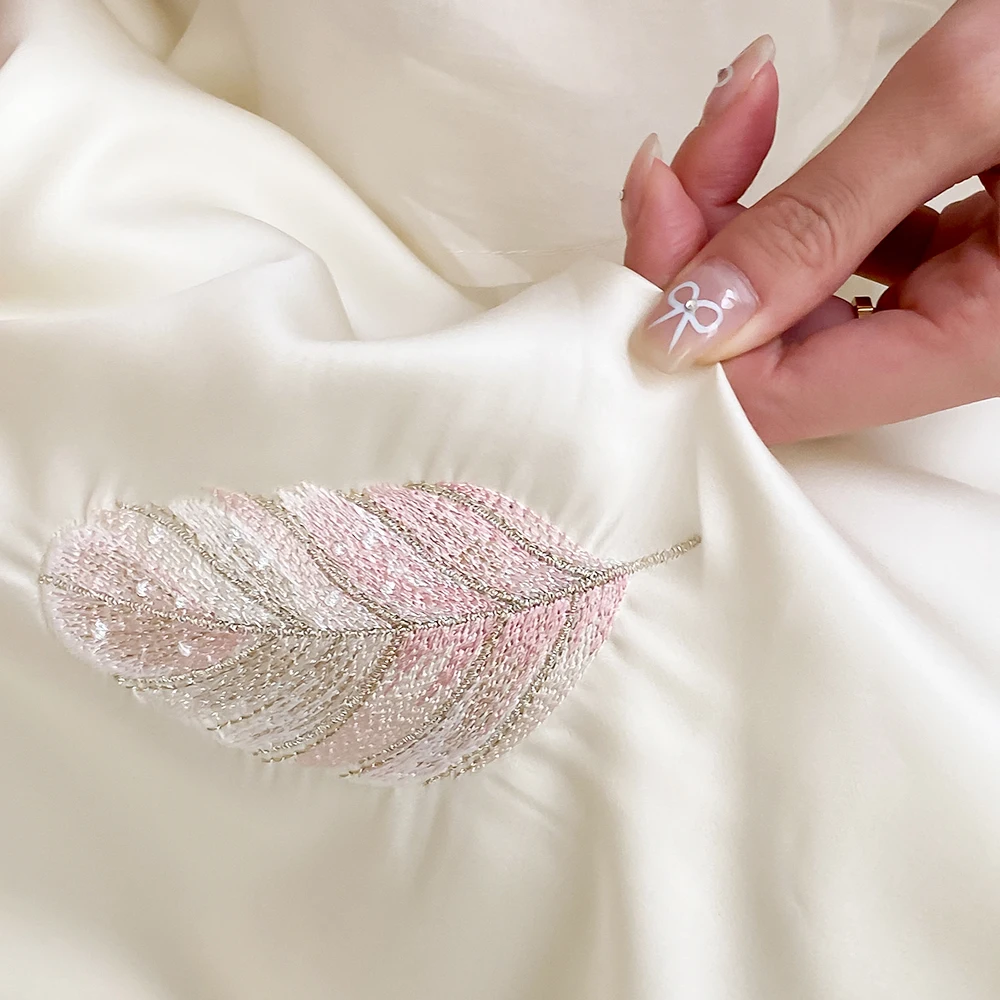
Mulberry Silk vs. Other Bedding Materials: A Comparison for Sensitive Skin
When evaluating bedding options for sensitive skin, understanding the key differences between materials helps inform the best choice for your specific needs.
| Feature | Mulberry Silk | Cotton | Bamboo | Synthetic Satin |
|---|---|---|---|---|
| Fiber Structure | Natural protein fiber (12-15 microns) | Plant fiber with rough edges (20-30 microns) | Processed plant cellulose | Chemical polymers |
| Friction Coefficient | Very low (0.1-0.2) | Moderate-high (0.5-0.6) | Low-moderate (0.3-0.4) | Low (0.2-0.3) |
| Moisture Handling | Balances without over-absorbing (11%) | High absorption (27%) | High absorption (20%) | Poor moisture management |
| Allergen Resistance | Naturally resistant | Harbors allergens | Moderate resistance | Variable resistance |
| Temperature Regulation | Excellent natural regulation | Moderate | Good | Poor |
| Chemical Treatment | Minimal | Often extensive | Extensive processing | Entirely synthetic |
| Breathability | Excellent | Good | Good | Poor |
| Benefit Duration | Retains properties for years | Diminishes with washing | Moderate durability | Variable quality |
While cotton remains popular due to its availability and lower cost, its rough fiber structure and high absorbency make it problematic for sensitive skin. Bamboo offers improvements in smoothness but requires extensive chemical processing to transform wood pulp into fabric, potentially introducing irritants.
Synthetic satin, while smooth, lacks the natural protein structure and breathability of true silk. It also tends to generate static electricity, which can attract airborne particles to your skin and bedding.
The complete guide to mulberry silk bed sheets provides more detailed comparisons, but the key takeaway is that mulberry silk offers a unique combination of benefits that no other material can fully match—particularly for those with sensitive skin concerns.
Quality Markers: Selecting the Best Mulberry Silk for Sensitive Skin
Not all silk is created equal, especially when it comes to sensitive skin benefits. Understanding key quality indicators ensures you select bedding that delivers the maximum therapeutic advantage.
Momme Weight
Momme (mm) measures silk fabric density—similar to thread count but more accurate for silk:
– 16-19 momme: Lighter weight, suitable for summer but less durable
– 19-22 momme: Optimal balance of weight, durability, and skin benefits
– 22-25 momme: Premium weight with enhanced durability and maximum skin benefits
– Above 25 momme: Ultra-luxury, but may sacrifice some breathability
For sensitive skin, 19-25 momme provides the ideal balance of smoothness, durability, and breathability.
Grade 6A Long-Strand Silk
Silk grades range from A to 6A, with 6A representing the highest quality:
– 6A indicates silk made from the longest, strongest, and most consistent fibroin strands
– Longer strands mean fewer joins in the yarn, resulting in smoother fabric
– Higher grades provide more consistent benefits and greater durability
– Lower grades may contain shorter fibers that create more texture and potential irritation
OEKO-TEX Certification
This independent certification ensures textiles are free from harmful substances:
– Guarantees testing for over 100 harmful substances
– Particularly important for sensitive skin to avoid chemical irritants
– Ensures dyes and processing agents meet strict safety standards
– Look for “STANDARD 100 by OEKO-TEX” labeling
Pure Mulberry Silk vs. Blends
Be wary of misleading terminology in the market:
– “Silk satin” often contains polyester and minimal actual silk
– “Silk-feel” or “silky” usually indicates entirely synthetic material
– “Silk blend” may contain as little as 10% actual silk
– For maximum skin benefits, choose only 100% pure mulberry silk
Mulberry silk pillowcases with these quality markers provide essential protection for facial skin, which tends to be most sensitive and visible. Investing in high-quality silk bedding ensures you receive the full range of skin benefits rather than just the luxurious feel.
Essential Care Guide: Maintaining Silk’s Skin-Friendly Properties
Proper care of your mulberry silk bedding preserves its skin-friendly properties for years to come. Following these guidelines ensures your investment continues to benefit your sensitive skin.
Proper Washing Techniques
- Wash every 7-10 days to prevent buildup of skin oils and cells
- Use pH-neutral detergent specifically formulated for silk (around pH 7.0)
- Wash in cold or lukewarm water (maximum 86°F/30°C)
- Select the delicate/silk cycle on your washing machine
- Hand washing is ideal but not required with proper precautions
- Turn pillowcases inside out before washing to protect the surface
Drying Methods
- Never tumble dry on high heat
- Air drying away from direct sunlight is ideal
- If using a dryer, select the lowest heat setting
- Remove promptly while still slightly damp to prevent wrinkles
- Lay flat or hang to complete drying
Storage Practices
- Ensure silk is completely dry before storing
- Use breathable cotton storage bags rather than plastic
- Store in a cool, dry place away from direct sunlight
- Avoid cedar chests as oils can damage silk proteins
- Don’t compress silk for long periods to prevent permanent creasing
Extending Longevity
- Rotate between two sets of silk bedding to extend their life
- Remove makeup and skincare products before sleep
- Consider using a silk sleep mask to protect pillowcases from eye creams
- Trim fingernails to prevent snagging the delicate fabric
The natural proteins in silk make it surprisingly resilient when properly maintained. Well-cared-for silk bedding can retain its skin benefits for several years, making it both a therapeutic choice and a sound investment. Why choose mulberry silk sheets becomes even clearer when considering their durability combined with unmatched skin benefits.
What Dermatologists Say: Expert Perspectives on Silk for Skin Health
Dermatological professionals increasingly recognize the benefits of silk bedding for skin health, particularly for patients with chronic skin conditions or sensitivity issues.
“The fabric you sleep on can have significant impacts on skin condition,” explains one dermatologist specializing in sensitive skin care. “The reduced friction of silk can help prevent the micro-irritation that exacerbates conditions like eczema and acne.”
Another skin expert notes: “For my patients with rosacea or facial redness, I often recommend silk pillowcases as part of their management plan. The temperature regulation and gentle surface can noticeably reduce morning flare-ups.”
Dermatologists particularly highlight silk’s benefits for:
– Reducing contact irritation during sleep
– Supporting the skin barrier function overnight
– Minimizing sleep-induced wrinkles and creases
– Maintaining hydration levels in compromised skin
– Reducing bacterial transfer compared to cotton
While dermatologists caution that bedding alone isn’t a cure for serious skin conditions, many view high-quality silk as a valuable component in comprehensive skin management. They emphasize seeking out verified pure mulberry silk rather than synthetic alternatives that may look similar but lack the protein structure that provides genuine benefits.
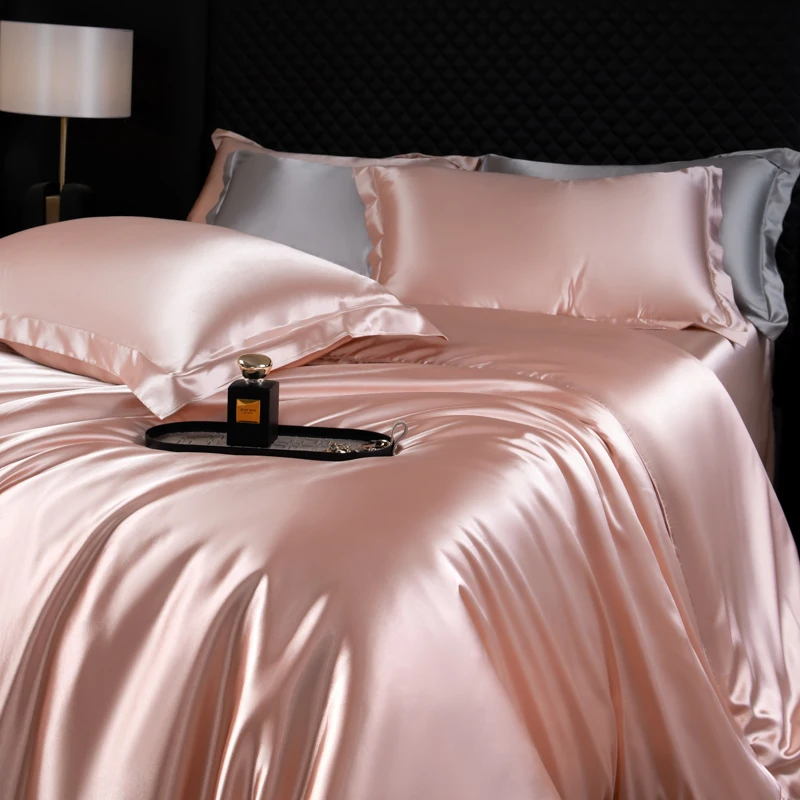
100% Silk Sheets, Green Silk Sheets, King Size Silk Bedding Set, Mulberry Silk Bedding Sets, Queen Size Silk Bedding Set
Price range: $1,246.21 through $1,615.22 Select options This product has multiple variants. The options may be chosen on the product pageBamboo Silk Sheets, Cooling Silk Sheets
Price range: $130.76 through $177.80 Select options This product has multiple variants. The options may be chosen on the product page100% Silk Sheets, King Size Silk Bedding Set, Mulberry Silk Bedding Sets, Queen Size Silk Bedding Set, White Silk Sheets
Price range: $1,000.79 through $1,351.42 Select options This product has multiple variants. The options may be chosen on the product pageKing Size Silk Pillowcases, Mulberry Silk Pillowcases, Queen Size Silk Pillowcases
Price range: $94.96 through $121.56 Select options This product has multiple variants. The options may be chosen on the product pageMulberry Silk Fitted Sheet, Mulberry Silk Sheets
Price range: $486.21 through $944.97 Select options This product has multiple variants. The options may be chosen on the product page100% Silk Sheets, Queen Size Silk Fitted Sheet, Queen Size Silk Pillowcases, Queen Size Silk Sheets
Price range: $259.05 through $284.13 Select options This product has multiple variants. The options may be chosen on the product page
Is Mulberry Silk Worth the Investment for Your Skin?
The premium price of quality mulberry silk often raises the question: is it truly worth the investment for sensitive skin? Consider these factors when making your decision:
- Properly maintained silk sheets typically last 2-3 years compared to cotton’s 1-2 years, making the per-year cost more reasonable than it initially appears
- The potential reduction in spending on topical treatments for irritated skin
- Improved sleep quality that impacts overall skin health and appearance
- The value of waking without new irritation, creases, or flare-ups
- The dual benefit of therapeutic properties and luxurious comfort
For those with chronic skin conditions like eczema, rosacea, or persistent sensitivity, the cost-benefit analysis often strongly favors silk. The nightly relief and cumulative benefits typically outweigh the initial investment.
When viewed as a therapeutic tool rather than simply a luxury purchase, mulberry silk becomes a practical choice for sensitive skin management. Many users report that the transform sleep quality complete guide principles involving silk bedding have changed not just their sleep but their overall skin health trajectory.
Common Questions About Mulberry Silk and Sensitive Skin
Can mulberry silk completely cure skin conditions?
Silk bedding isn’t a cure for underlying skin conditions, but it can significantly reduce symptoms and prevent additional irritation. Think of it as removing an aggravating factor rather than providing a complete treatment.
Is silk still beneficial if you use a moisturizer at night?
Absolutely—silk actually works better with nighttime skincare than cotton does. Silk allows your products to stay on your skin rather than being absorbed into the fabric, potentially enhancing their effectiveness.
How quickly might you notice improvements in skin condition?
Most users report noticeable differences within 2-3 weeks of consistent use. Initial improvements often include reduced morning redness and fewer new irritations, with cumulative benefits developing over longer periods.
Are silk pillowcases alone sufficient, or are full sheets recommended?
Pillowcases provide significant benefits for facial skin and are an excellent starting point. However, for conditions affecting the body (like widespread eczema or sensitive skin), full sheets offer more comprehensive protection.
How does silk compare to medical-grade fabrics for severe conditions?
Mulberry silk offers many similar benefits to specialized medical fabrics but with superior comfort and aesthetic appeal. For very severe conditions, consult your dermatologist about whether silk or specialized medical textiles would be more appropriate.
The advantages of sleeping on mulberry silk extend beyond sensitive skin to include hair benefits, temperature regulation, and improved sleep quality. This makes silk bedding a holistic wellness choice rather than simply a skin care solution.

